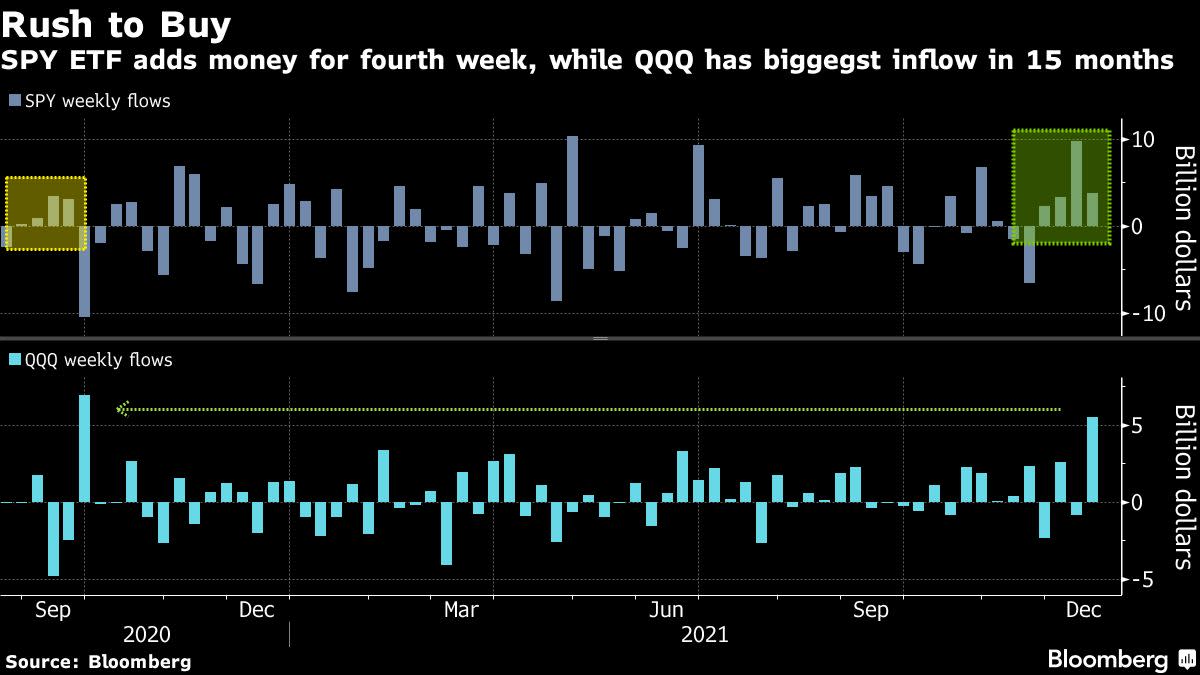
(Bloomberg) — Buying after a plunge, a trade rewarded virtually every time stocks pulled back in 2021, is facing a big challenge.
Down hard for a second day Monday, the S&P 500 has now posted back-to-back, 1%-plus swoons twice in the past month, something it has mostly avoided doing before. It’s a worrying departure from the recent past, when 1% drops were trimmed or erased the next day 68% of the time, making 2021 one of the best years ever for dip buyers.
The failure to bounce is rattling those conditioned to anticipate it and comes as a litany of stressors weighs on bulls. Last week, when the S&P 500 fell on all but one day, investors poured $30 billion into exchange-traded funds focusing on U.S. equities, the largest inflow since March, according to data compiled by Bloomberg.
To their chagrin, stocks started the new week on another sour note, with Senator Joe Manchin’s rejection of President Joe Biden’s tax-and-spending package adding to a long list of market worries from a hawkish Federal Reserve to the fast-spreading omicron variant.
While the S&P 500’s ability to stem declines at a widely watched chart level can be soothing to bulls betting on a repeat of a historically favorable seasonal pattern into year-end, the murky economic outlook means many traders may be ready to book profits in a year where the index has surged 20%.
The market is poised “to take a pause after a huge run. It’s tired and it has worked hard,” Bob Doll, chief investment officer at Crossmark Global Investments, said in an interview on Bloomberg TV with Alix Steel. “The Fed has said ‘we are going to take the punch bowl away.’ We can all debate the pace of that, but the Fed is moving from our best friend and they will eventually be our worst enemy when it comes to the market.”
The S&P 500 ended down 1.1%, though it managed to battle back from a rout that approached 2% at its deepest. The drop is the fifth in six sessions, one of the worst stretches of volatility since the pandemic selloff in early 2020. With the Fed ramping up hawkishness and the omicron variant prompting more travel restrictions worldwide, the market’s tone is taking a subtle shift.
Already, buying fatigue has crept up in the riskiest corners. Over the past few weeks, the Russell 2000 of small-caps fell into a 10% correction, newly minted shares sank into a bear-market decline of 20%, and a group of profitless technology firms plunged almost 30%.
“The aggressive ‘buy the dip’ mentality, which proved so profitable for the last 1.5+ years, especially in the high-multiple corners of the market, was underwritten by a tidal wave of stimulus that is now receding,” wrote Adam Crisafulli, the founder of Vital Knowledge.
For large-cap stocks, however, dip buyers refused to give up last week. The SPDR S&P 500 ETF Trust (ticker SPY) attracted money for a fourth straight week, the longest streak of inflows since September last year. The Invesco QQQ Trust (QQQ), the largest ETF tracking the Nasdaq 100, added about $5.5 billion of fresh money last week, the most in 15 months.
It’s not hard to see why bulls prefer to stick around. For now, all the headline risk has yet to translate into any real damage for corporate earnings, one key pillar supporting this bull market. In fact, analysts have been ratcheting up their 2022 profit forecasts over the past month, with their estimated income for all S&P 500 firms rising by more than $1 to $221.10 a share.
As ominous as the daily drubbing looked, the S&P 500 has managed to stay above its average price in the past 100 days, a trendline that has consistently acted as a floor during every major selloff since the pandemic bear market. During Monday’s trading, the index came within points of the threshold — which recently stood near 4,523 — before bouncing back.
“The market has been so far fairly patient and not over-reacting,” Lori Calvasina, head of U.S. equity strategy at RBC Capital Markets, said in an interview on Bloomberg TV. “That’s the way it will continue and properly so for the next few weeks.”
©2021 Bloomberg L.P.